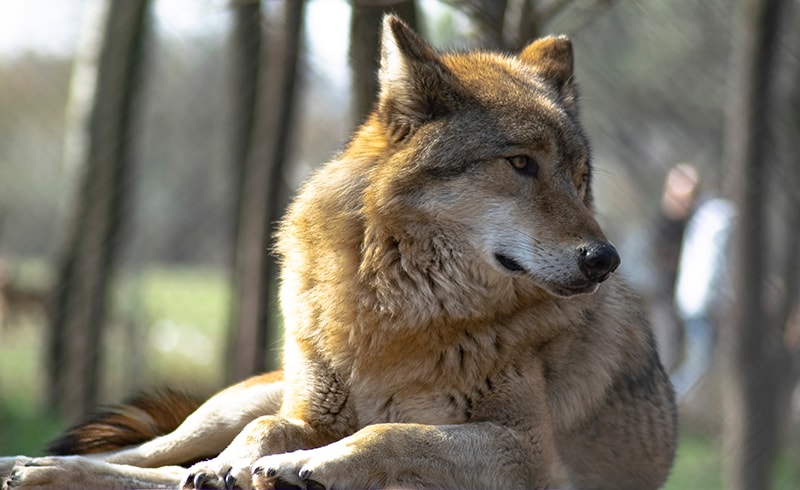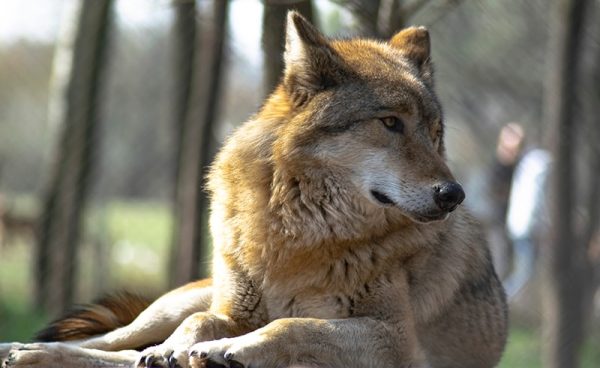Click Below to Skip Ahead
The American Indian Dog is an incredibly rare dog that is kept by small, dedicated populations. The American Indian Dog is a breed that attempts to capture the original DNA of the pre-European dogs that lived in North America alongside the indigenous population. Many indigenous North American dogs vanished or were interbred with European dogs after the arrival of Christopher Columbus and then the Spanish and British, leaving precious few bloodlines that predate 1492. The American Indian Dog is an attempt to rectify that while also paying homage to the unique dogs that were here long before the arrival of the Europeans.
Note: Some people find the term “American Indian” to be outdated language. Many people accept the term Native American or Indigenous Peoples instead of “American Indian.” The use of the term American Indian in this article is to keep in line with the name of the breed, which is officially recognized by Wisdom Panel as a distinct breed worthy of documentation despite the language used.
Breed Overview
Height:
12 – 18 inches
Weight:
30 – 60 pounds
Lifespan:
12 – 18 years
Colors:
Black, blue, white, gray, fawn, and silver
Suitable for:
Active people who love the outdoors and are looking for a unique dog with oodles of culture
Temperament:
Intelligent, versatile, hardworking, and loyal
The American Indian Dog is a wolf-like breed that has features of wild dogs, dingoes, and wolves. They are of medium build and have a sleek and angular body. American Indian Dogs were bred to be companions and herding dogs, so they have a combination of a working drive and loyalty that is prized by dog owners of all stripes. Some people think that American Indian Dog refers to any type of indigenous canine, but that is a misunderstanding. There are indigenous dogs that still live side-by-side with indigenous populations, but they are not the same thing as an American Indian Dog.
American Indian Dog Characteristics
American Indian Dog Puppies
American Indian Dogs are exceedingly rare. They are not recognized by the American Kennel Club (AKC), which means that they don’t appear on most internet lists of registered AKC breeders. American Indian Dogs are not widespread, and many people don’t even know that they exist. This means that finding an American Indian Dog puppy is nearly impossible unless you know exactly where to look. There are niche breeders that live in specialized regions where these dogs are more common, often on reservations or in the American West. The chance of accidentally stumbling on an American Indian Dog puppy is zero. The chance of finding a breeder in your area that specializes in American Indian Dogs is rare.
The best way to find an American Indian Dog puppy is to try to contact the International Indian Dog Owners and Breeders Association, which is the official breeding organization of the American Indian Dog.
American Indian Dog Breed Origin & History
The origins of the American Indian Dog stretch back many centuries to the days before Europeans appeared on the shores of North America. Indigenous dogs lived alongside Native Americans for generations, where they were used as hunters, herders, companions, and even for meat during hard times.
The origins of the American Indian Dog breed began in the middle of the 20th century. A person by the name of Kim La Flamme set out on a mission to trace and preserve lineages of dogs that could trace their parentage beyond Christopher Columbus. La Flamme traveled to native communities in the United States, Canada, and Mexico. Along the way, they spoke to numerous native leaders and examined dozens of dogs. After years of work and exploration, La Flamme chose a stable of dogs to use as the foundation for the breed of American Indian Dog. Despite the passion and extensive research, La Flamme admits that there is no way to know for sure if these dogs have 100% pure bloodlines untainted by European dogs, which is why many breeding organizations shun the American Indian Dog to this day.
Temperament & Intelligence of the American Indian Dog 🧠
The American Indian Dog is a very active and loyal breed. They are very intelligent and take well to training from people with whom they have bonded. These dogs are able to participate in structured and competitive activities. Some American Indian Dogs can be wary of strangers, and they are often alert. Many people have used these dogs as alert dogs in remote areas. American Indian Dogs typically bond with two or three people who they become devoted to and can be unfriendly to everyone else.
Are These Dogs Good for Families? 🏡
Sometimes. American Indian Dogs are known to bond strongly with a handful of people that they see as their pack. American Indian Dogs are extremely pack motivated. That means that these dogs will be phenomenal with their owners, but they can be wary and stand-offish with strangers. This can make them awkward to deal with if you have frequent guests, small children, or new children. American Indian Dogs will blend with most families seamlessly but there will be some obstinate examples of American Indian Dogs that are anxious or unfriendly toward members of the household that they did not bond with.
Does This Breed Get Along With Other Pets? 🐶 😽
Sometimes. American Indian Dogs often get along with other dogs. American Indian Dogs like to form groups with other canines. This behavior is usually done while outside or interacting with other dogs in a natural setting, but it can also occur within a household. As herding and hunting dogs, American Indian Dogs might not get along well with small pets like cats. Many will, but some won’t.
Things to Know When Owning an American Indian Dog:
Food & Diet Requirements 🦴
American Indian Dogs will do well with a well-formulated dry food. American Indian Dogs should eat food that matches the stage of their life. Puppies should eat puppy food, adults should eat adult food, and seniors should eat senior food. Active American Indian Dogs might benefit from an active lifestyle dog food that focuses on protein and joint health. Many people use training treats with American Indian Dogs, and treats can be a great motivator. But treats can also be a source of excess calories. Excess calories can cause obesity in this breed, which leads to lasting health problems. A dog should not receive more than 10% of their calories from treats.
Exercise 🐕
American Indian Dogs need lots of exercise, both moderate high intensity. This is because the American Indian Dog is a working dog with large energy reserves. These dogs will benefit from two long walks per day. They will also need an outdoor area to roam and run. Many American Indian Dogs are allowed to roam free on their respective homesteads. You will also want to consider taking your dog out for some structured exercise and activities such as hiking, biking, or running. American Indian Dogs also do well at dog sports such as agility or competitive herding. In 2016, an American Indian Dog won an AKC obedience competition, highlighting their ability to be competitive in structured sports.
Training 🦮
American Indian Dogs are highly trainable, and they respond very well to their owners. A combination of positive reinforcement and training treats can work wonders on an American Indian Dog. As stated, these dogs have the potential to thrive at things like agility and obedience, which shows how trainable these dogs are. Socialization of American Indian Dogs is highly recommended, especially when they are young. Since these dogs can be anxious and wary around strangers, socialization is key to ensuring that your dog is well behaved around unfamiliar people or when they are not feeling 100% secure.
Grooming ✂️
Most American Indian Dogs have a rugged double coat that requires little maintenance. Active or outdoorsy American Indian Dogs will benefit from weekly brushing and baths as needed. These dogs will shed during shedding season, which typically occurs in late spring and early autumn. American Indian Dogs also need regular nail trims and dental cleanings to keep them looking and feeling their best. Overall, the grooming requirements for an American Indian Dog are moderate at worst and low at best.
Health and Conditions ❤️
Since American Indian Dogs are so rare, they do not have a strong health profile from which to pull. Due to low populations and remote living conditions, there is not as much information about the overall health of the breed as there is with other types of dogs. Many American Indian Dog populations exist in areas where regular vet care or corporate medicine is sparse, leading to a gap in the overall knowledge about the breed’s health issues. One of the only confirmed health issues noted in the breed is hip dysplasia, which is very common. These dogs are found to be typically healthy; this is reflected in their life span, which can stretch to an impressive 18 years in ideal conditions.
- None to note
Male vs Female
The two biggest differences between male and female American Indian Dogs are size and personality. Females are considerably smaller than males. Female American Indian Dogs can stand multiple inches shorter than males and weigh as much as 20 pounds less. Males are often more protective and more aggressive than females. While American Indian Dogs are not particularly aggressive, they can be watchful and protective of their owners. These traits seem more prevalent in the larger males than the more diminutive females.
3 Little-Known Facts About the American Indian Dog
1. American Indian Dogs Are Not Recognized by the AKC
American Indian Dogs are not recognized by the American Kennel Club. The American Indian Dog is primarily recognized by the International Indian Dog Owners and Breeders Association. This is due to the American Indian Dog’s newness and rarity.
2. American Indian Dogs Are Often Conflated With Other Breeds
American Indian Dogs are often conflated with other breeds. The American Indian Dog is often mistaken for dogs indigenous to North America, such as the Canadian Eskimo Dog and the Alaskan Malamute. But the American Indian Dog is a specific breed, not an umbrella term.
3. American Indian Dogs Represent One of the Few Remaining North American Bloodlines
Thanks to the efforts of Kim La Flamme, the American Indian Dog remains one of the only breeds that tries to maintain a pure bloodline that only contains dogs that are native to North America. While some people have called this effort into question, the goal has always been the same: identify and preserve the North American canine bloodline in one special breed. Most dogs are a mashup of genes from multiple continents, primarily Europe. This leaves very few dogs with bloodlines that remain free from crossbreeding with non-native dogs.

Final Thoughts
The American Indian Dog is an exceedingly rare and interesting breed. The American Indian Dog is a relatively new breed that arose from a noble goal. The breed is largely unknown in the general population and locating them is a challenge. However, the lucky few who manage to get their hands on one of these noble hounds are sure to be delighted by their athleticism, loyalty, and history.
Featured Image Credit: Ungvari Roland, Shutterstock










